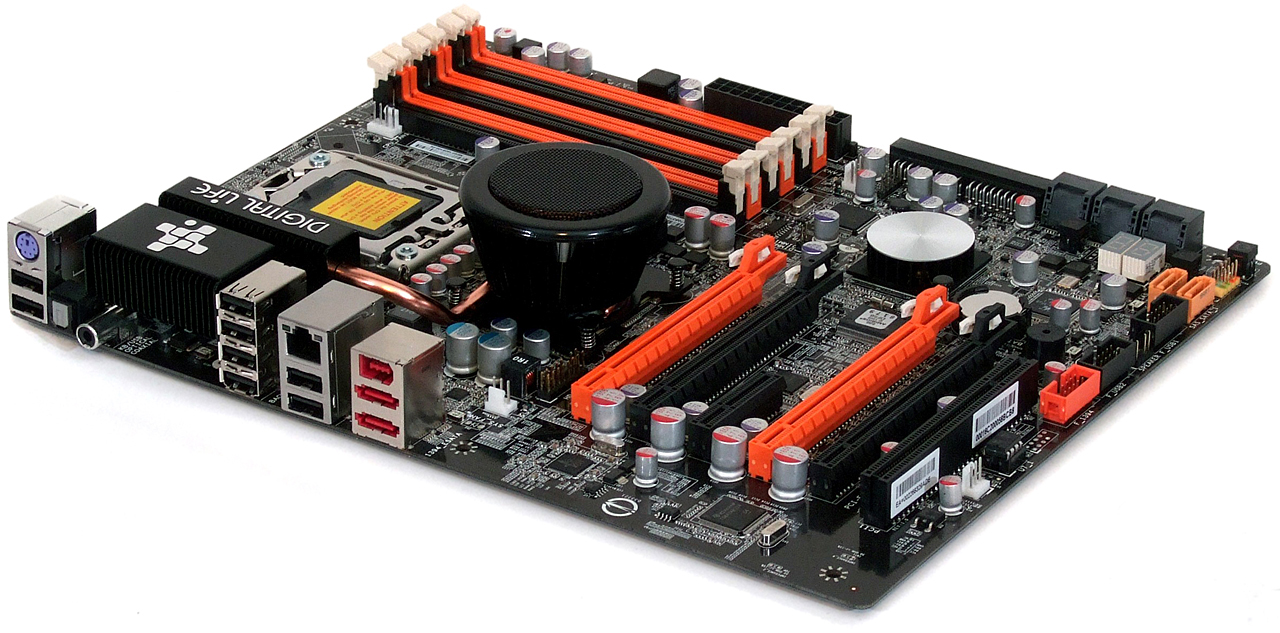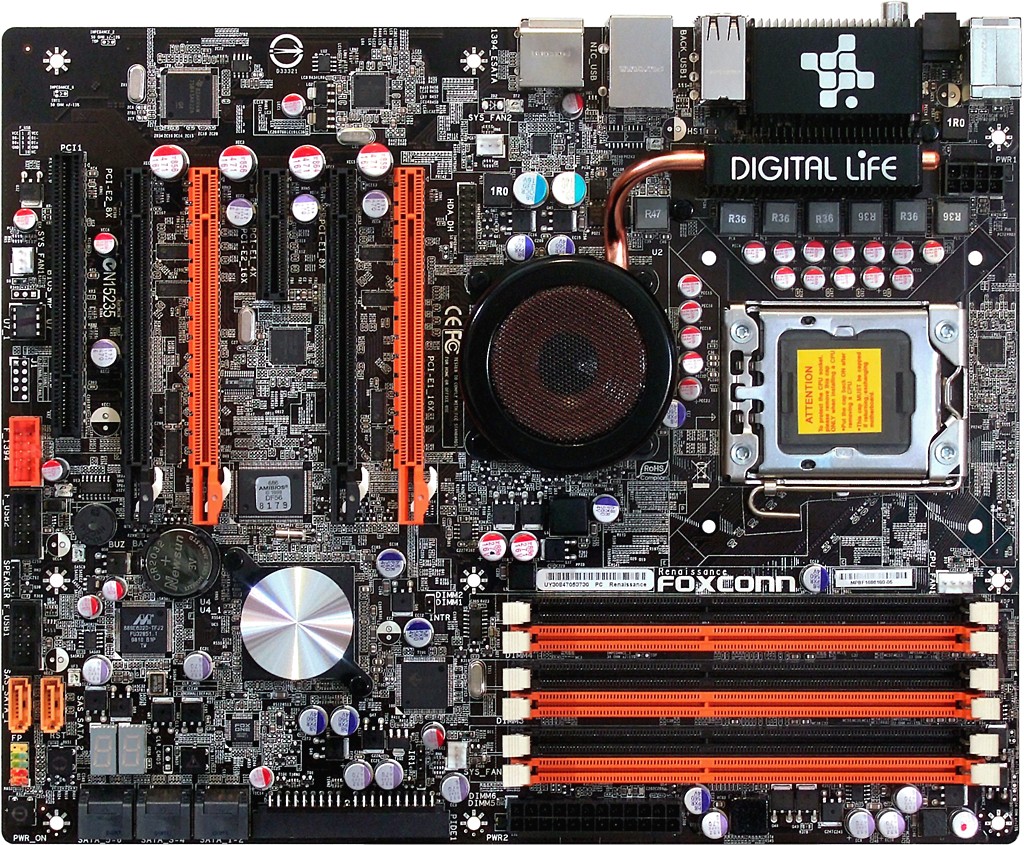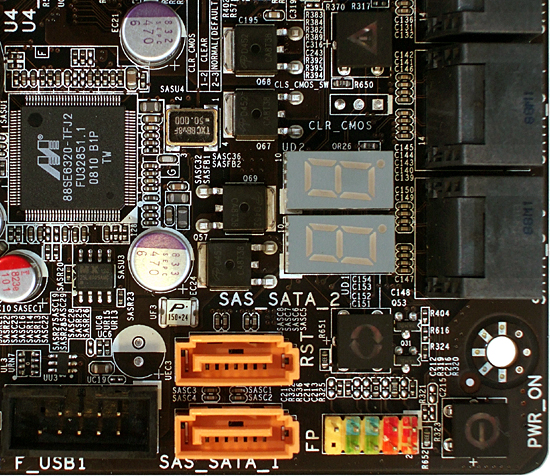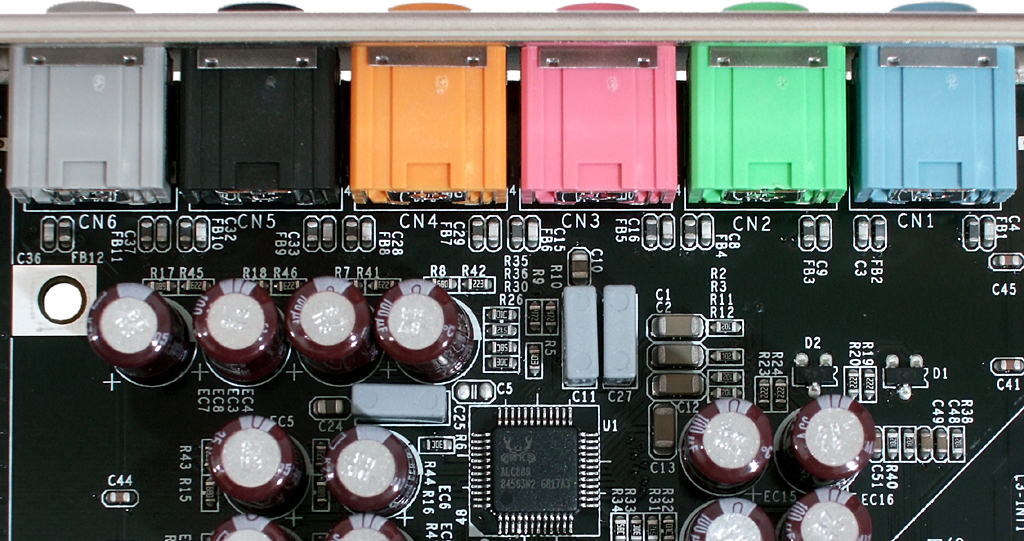X58 Roundup: Seven $200-300 Core i7 Boards
Foxconn Renaissance
Features and Layout
The Renaissance motherboard is packed with advanced features with which Foxconn hopes to build value for its customers. For example, it’s the only board in its price class to use an audio riser card for reduced noise, the only board in today’s comparison to provide Serial Attached SCSI, and one of only two in this price class to support up to four PCI Express graphics cards.
Electronic pathway switches cost money, but that didn’t prevent Foxconn from using them on two slots to provide graphics cards with either x16/x16 or x8/x8/x8/x8 transfer modes. For multi-graphics users, Foxconn really stands out.
On the other hand, slot spacing prevents the Renaissance from being taken seriously as a quad-CrossFire or 3-way SLI product, since high-performance cards normally require two slots of space. Instead, this might be an ideal low-end workstation board, or the perfect solution for a high-end multitasking system. It still supports 2-way SLI using double-slot cards of course, but a builder might feel somewhat silly for covering the up the extra graphics card slots.
With so much attention paid to the features list, we can’t quite figure out why Foxconn didn’t use an open-ended x4 slot in the middle. Using the left-over PCIe 2.0 pathways of the X58 northbridge, the slot would have made an ideal place to put a fifth graphics card in a wild multi-display configuration. It still supports hot performance cards, but the closed end also prevents PCIe x8 RAID controllers from fitting.
Windows Vista users who don’t have a problem with the slightly odd slot placement will find the remaining connectors almost perfectly placed. Our only caveat for them is to choose a case that can accept forward-facing SATA ports, since a few have drive cages in the way.
The reason we limited our last comment to a specific OS is that XP users will find no floppy header for loading AHCI or RAID drivers. This can still be accomplished by slipstreaming drivers onto the OS CD or by purchasing a USB floppy drive.
Get Tom's Hardware's best news and in-depth reviews, straight to your inbox.
The Port 80 diagnostics display is surrounded by a CLR_CMOS, Power and Reset buttons, two SATA-compatible SAS ports, and the PCIe x1 SAS controller. As with any x1 device, total bandwidth is limited by the interface to 2.5 Gb/s.
| Foxconn Renaissance (Initial Revision) | |
|---|---|
| Northbridge | Intel X58 Express |
| Southbridge | Intel ICH10R |
| Voltage Regulator | Six Phases |
| BIOS | 080015 (2/18/2009) |
| 133.3 MHz Base Clock | 133.3 (+0.0%) |
| Clock Generator | ICS 9LPRS139AKLF |
| Connectors and Interfaces | |
| Onboard | 4 x PCIe 2.0 x16 (Pathways Shared in Pairs) |
| 1 x PCIe 2.0 x4 | |
| 1 x PCI | |
| 1 x Foxconn Audio Riser (Proprietary) | |
| 2 x USB 2.0 (2 ports per connector). | |
| 1 x IEEE-1394 FireWire | |
| 1 x Ultra ATA (2 drives) | |
| 6 x Serial ATA 3.0Gb/s | |
| 2 x SAS 3.0Gb/s | |
| 1 x Fan 4-pin (CPU) | |
| 3 x Fan 3-pins (Chassis, Power) | |
| 1 x Power button | |
| 1 x Reset button | |
| 1 x Clear CMOS button | |
| 1 x Port-80 Diagnostics Display | |
| IO panel | 1 x PS2 (keyboard) |
| 8 x USB 2.0 | |
| 2 x Digital Audio Out (Optical, Coaxial) | |
| 1 x RJ45 Ethernet | |
| 1 x IEEE-1394 FireWire | |
| 2 x External SATA (eSATA) 3.0Gb/s | |
| Mass Storage Controllers | |
| Intel ICH10R | 6 x SATA 3.0Gb/s (RAID 0, 1, 5, 10) |
| JMicron JMB363 PCIe | 1 x Ultra ATA-133 (2-drives) |
| 2 x External SATA (eSATA) 3.0 Gb/s | |
| Marvell 88SE6320 PCIe | 2 x SAS 3.0Gb/s (RAID 0, 1) |
| Network | |
| Broadcom BCM5706 PCIe | Dual Gigabit LAN with Teaming |
| Audio | |
| Foxconn Harp Riser Card (Realtek ALC889 HD Audio Codec) | Eight-Channel (7.1 Surround) Output Supports DTS Connect, Dolby Digital Live |
| IEEE-1394 FireWire | |
| Texas Instruments TSB43AB22A | 2 x FireWire 400 (1x Internal, 1x I/O Panel) |
Limited by its PCIe x1 interface to a combined bandwidth of 2.5 Gb/s, the JMicron JMB363 provides the Renaissance with two eSATA ports and an internal Ultra ATA-133 connector.
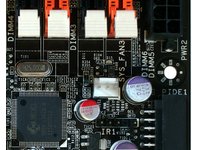
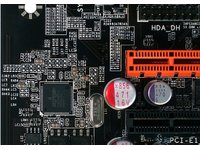
A PCIe x1 chipset link doesn’t impose such limits on Broadcom’s BCM5706 controller, simply because it has only one Gigabit network port.
One of the more interesting Renaissance features is its Harp riser card. Using the same hardware as the Sonar X-Fi of Foxconn’s pricier BloodRage motherboard, the Harp doesn’t include Creative’s audio software. Its ALC889 codec does support other advanced features such as 8+2 channel multi-streaming. Two competing technologies, DTS Connect and Dolby Digital Live, allow on-the-fly compression of live multi-channel audio to a single digital output.
Check prices for Foxconn's Renaissance
Current page: Foxconn Renaissance
Prev Page EVGA X58 3X SLI Next Page Renaissance BIOS, Software, And Accessories-
dragonsprayer hey guys good info - its 4am i should not be posting with one eye closed to see the screen!Reply
Warpedsystems has tested a least half of these, my Evga failed out of the box, i would normally let that slide but with all the 680i and 780i issues and failures over the years - beware. So i can not speak of the evga - i will say the 780i FTW is kick butt mobo!
Asus is asus and 90% or so of my stuff i ship, i switched to the new P6t from the deluxe and have had some issues - i am sitll working on the P6T tonight as i type. Opps- my jr tech set the blk to 180 and over clocked the QPI to max - i think he smoked the mobo ran amd cpu = its first in 5 years if so?
Some did not make it? no gigabyte? gigabyte is really pushing on asus for number one - really! Ya, all the evga fans are what? I can say how many evga mobos break and fail: pci-e slot fail, pressure around the cpu mounting failure, lock ups - evga lock ups are just accepted as part of life! We all know that evga error code!
I have to say the gigabyte and the higher end asus deluxe version sure seem a lot more reliable for 4ghz systems - again - we only took 1 evga and it locked up and i said "that is it the last time" - the FTW 780i gives me faith evga will come around on x58.
what ever you do - do not oc the blk and QPI - poof!
nice stuff THG! -
Crashman dragonsprayerhey guys good info - its 4am i should not be posting with one eye closed to see the screen!Warpedsystems has tested a least half of these, my Evga failed out of the box, i would normally let that slide but with all the 680i and 780i issues and failures over the years - beware. So i can not speak of the evga - i will say the 780i FTW is kick butt mobo!Asus is asus and 90% or so of my stuff i ship, i switched to the new P6t from the deluxe and have had some issues - i am sitll working on the P6T tonight as i type. Opps- my jr tech set the blk to 180 and over clocked the QPI to max - i think he smoked the mobo ran amd cpu = its first in 5 years if so?Some did not make it? no gigabyte? gigabyte is really pushing on asus for number one - really! Ya, all the evga fans are what? I can say how many evga mobos break and fail: pci-e slot fail, pressure around the cpu mounting failure, lock ups - evga lock ups are just accepted as part of life! We all know that evga error code!I have to say the gigabyte and the higher end asus deluxe version sure seem a lot more reliable for 4ghz systems - again - we only took 1 evga and it locked up and i said "that is it the last time" - the FTW 780i gives me faith evga will come around on x58.what ever you do - do not oc the blk and QPI - poof!nice stuff THG!Reply
One of the companies forgot to send a board and didn't respond in time to the reminder...see the introduction of the article. What makes you think that company wasn't Gigabyte? -
Which ASUS board was actually tested - the plain "P6T" or "P6T SE?" There are subtle differences, like JMB322 in P6T but not in P6T SE. Also, some difference in e.g. back panel IO and advertised overclocking capabilities.Reply
Judging from the feature list, the board was plain P6T, but all pictures seem to be of P6T SE.
-
Crashman RipaWhich ASUS board was actually tested - the plain "P6T" or "P6T SE?" There are subtle differences, like JMB322 in P6T but not in P6T SE. Also, some difference in e.g. back panel IO and advertised overclocking capabilities.Judging from the feature list, the board was plain P6T, but all pictures seem to be of P6T SE.Reply
http://media.bestofmicro.com/7/3/192063/original/asus_p6t_kit.jpg -
wicko Sadly, none of the good mobos in this review are sub 300$ in Canada.. what a damn ripoff.Reply -
hardwarekid9756 Could you expound on "Catastrophic Failure?" I'd be interested to know what all went wrong in the fray. I've been using an ASRock Mobo recently, and noticed it full-out sucked at Overclocking when compared to my MSI board, so I'd like to know what exactly caused the thing to bomb out.Reply -
salavat23 No Gigabyte.Reply
Sorry, but you can't make a good review without including one of the top manufacturers of X58 motherboards. -
salavat23 No Gigabyte.Reply
Sorry, but you can't make a good review without including one of the top manufacturers of X58 motherboards. -
msdx_bizkit Gigabyte EX58-UD3R and MSI X58 Pro are the cheapest X58 motherboards out there at the moment. (~250$ CAD - NCIX) Could you guys give me your input on those two particuliar boards?Reply
I am not the extreme overclocking kinda guy. In fact, I still am running on default settings on my Core 2 Duo E6750. I don't plan to overclock over 3,2Ghz on my new 920, if I ever do overclock.
Neither boards support SLI, but I'd be interrested in a dual Radeon 4870 1GB Crossfire config.
Thanks in advance -
daft i was just wondering if the "more on this topic" could be omitted in future articles, i like to skip to the conclusion in the mornings and its annoying to hit more on this topic and get a little window than to go to the conclusionReply
